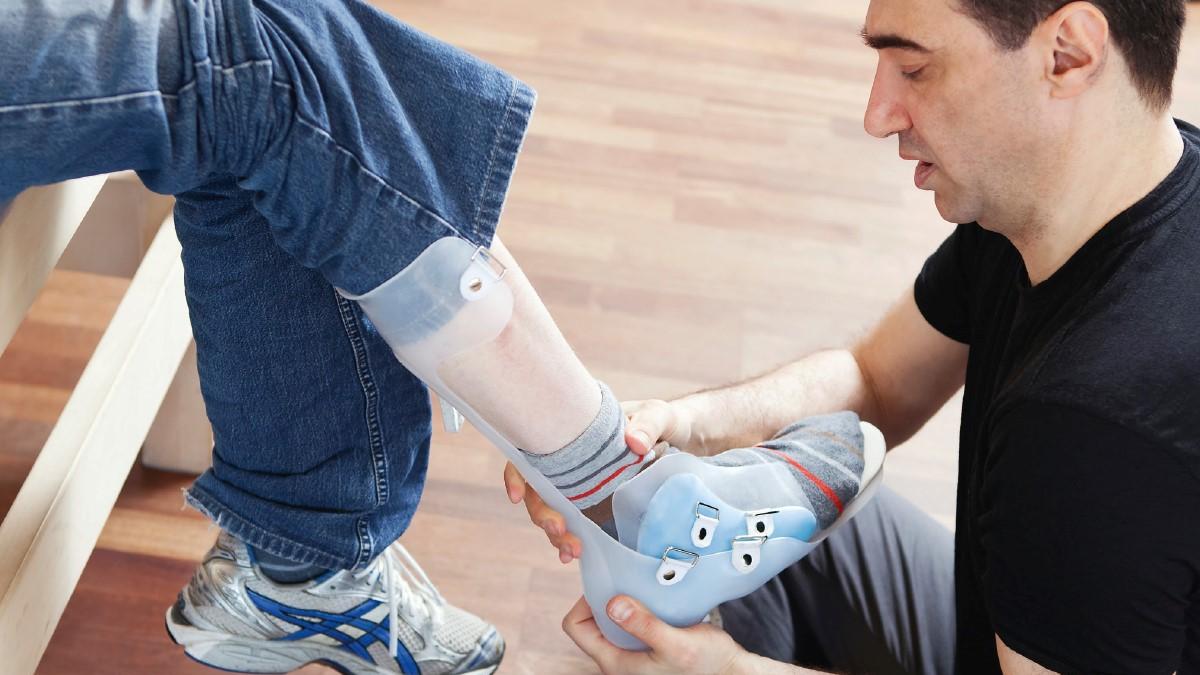Physiotherapy Journal editor Michele Harms and Caroline White report on recent research.

There isn’t enough good quality evidence on the value of using orthotics to tackle knee instability and associated impaired mobility in people with neuromuscular or central nervous system disorders, concludes a review of the available evidence.
The researchers reviewed 21 relevant studies involving 478 adults. Participants were using various different knee-ankle-foot, ankle-foot, and knee orthoses to help with mobility issues associated with post-polio syndrome, thalamic pain syndrome following a stroke, spinal cord injury and the inflammatory muscle disease inclusion body myositis.
The researchers looked particularly at the impact of orthotics on function, disability, independence, activities of daily living, quality of life; pain relief; walking ability; functional assessments; biomechanical analysis; side effects; patient satisfaction; and resource use.
The review included two randomised controlled trials, three non-randomised controlled studies, and 16 case series. Most were small, single-centre studies; only six of them monitored patients for one or more years. What’s more, the studies met few quality criteria and reported methods and results poorly.
The studies also focused primarily on outcomes related to gait analysis and energy consumption rather than standardised, validated, patient-reported outcome measures. And there was little evidence on issues of direct importance to patients, such as pain relief and fall risk.
High-quality research on orthotic devices for knee instability, with an emphasis on outcomes that matter to patients, is now needed, conclude the researchers. It may also be worth developing a national registry, they add. McDaid C et al. Systematic review of the evidence on orthotic devices for the management of knee instability related to neuromuscular and central nervous system disorders. BMJ Open 2017
Physiotherapy Journal
Physiotherapy editor Michele Harms highlights some ‘in press’ papers in the latest Physiotherapy Journal. As a CSP member, you can access the journal free via the CSP website.
High Crossover between arms in the UKUFF Rotator Cuff Trial
A study to compare surgical and non-surgical interventions for rotator cuff tears found that participants recruited did not remain within allocated treatment arms. This crossover led to the original trial design being reconfigured and one allocation (‘Rest then Exercise’) was halted. The researchers studied why this occurred by conducting in-depth, semi-structured interviews. They found that the factors which influenced crossover included long durations of severe pain and failed conservative treatment. Many participants had strong preferences and did not see the comparative management/treatments as equal. The authors also conclude that if conservative treatments are usually provided sequentially in clinical practice, it may be inappropriate to include them as comparators in surgical trials. Why participants in the United Kingdom Rotator Cuff tear (UKUFF) trial did not remain in their allocated treatment arm: a qualitative study, CJ Minns Lowe, J Moser J, K L Barker, DOI:dx.doi.org/10.1016/j.physio. 2017.09.002.
Physiotherapists and thoracic ultrasound (TUS)
The journal has recently published a number of scoping reviews. They provide a useful means of gaining an understanding of an emerging evidence base, in a new area of application or treatment. This review included 26 diverse papers illustrating the potential for varied uses of thoracic ultrasound and asked in which ways physiotherapists use TUS to inform their clinical or research practice. The authors found that the majority of papers involved the use of ultrasound to scan the diaphragm, with a focus on diaphragm function, and a smaller proportion involved scanning the pleura and lung parenchyma. The authors concluded that this novel and innovative technique clearly has potential in both diaphragm and lung diagnostics in the hands of the physiotherapy profession. Use of thoracic ultrasound by physiotherapists: a scoping review of the literature, SA Hayward, J Janssen, DOI:doi.org/10.1016/j physio.2018.01.001; www.physiotherapyjournal.com/article/S0031-9406(18)30001-4/pdf
L-test for people with Parkinson’s
The Timed Up and Go test has received attention in a wide variety of applications in recent years. The authors describe the L-test as an extended version of the Timed Up and Go test, incorporating a longer walking distance and turns in two directions. Their study aimed to determine the test-retest and concurrent validity of the L-test in a group of participants with mild to moderate Parkinson’s (with scores in the range of 1-3 on the Hoehn and Yahr scale). They report agreement between repeated measures and a strong correlation with the Timed Up and Go test; concluding that the L-test is a reliable and valid outcome measurement for the assessment of walking ability. They provide some guidance on meaningful changes in score in participants with mild to moderate Parkinson’s. The reliability and validity of the L-test in people with Parkinson’s disease, B Haas, E Clarke, L Elver, E Gowman, E Mortimer, E Byrd,DOI: doi.org/10.1016/j.physio. 2017.11.218;
Further reading
- High blood pressure may derail the body’s compensatory response to low levels of oxygen in the blood, suggests experimental research of middle-aged men. When oxygen levels are low – at altitude or during sleep apnoea, for example –blood supply to vital organs and tissues is increased to protect them. But this didn’t happen in men with high blood pressure after exposure to low levels of oxygen for five minutes. The Journal of Physiology 2018
- Certain types of asthma treatment may be linked to a heightened risk of infertility, suggests an international study of 5,000 women. Those who only used short-acting asthma relievers took longer to become pregnant than women without the condition. European Respiratory Journal 2018
- Women, but not men, experience seasonal changes in their mood throughout the year, including more depressive symptoms during the winter, indicates a UK study of 150,000 people. Journal of Affective Disorders 2018
Author
Caroline Wright and Michele Harms
Number of subscribers: 1
